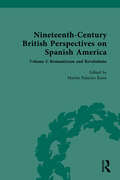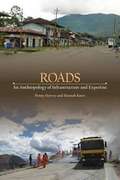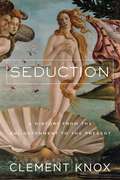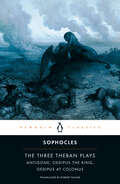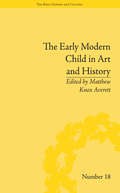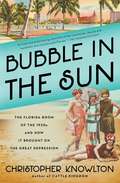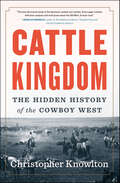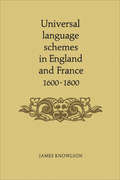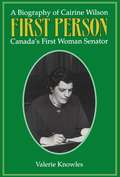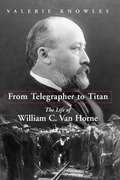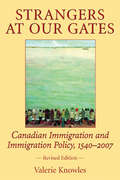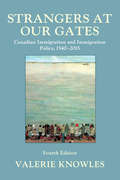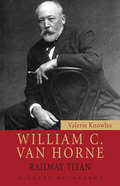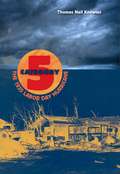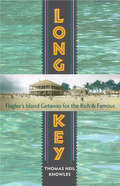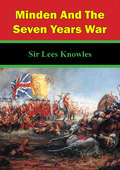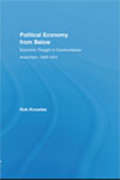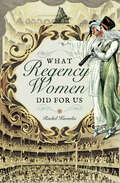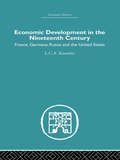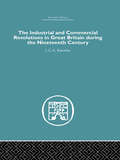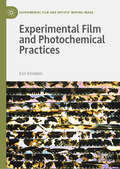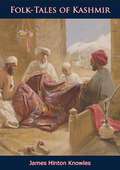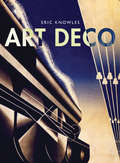- Table View
- List View
Nineteenth-Century British Perspectives on Spanish America: Volume I: Romanticism and Revolutions
by Marisa Palacios KnoxThe sources in this volume focus on Great Britain’s moral, financial, and diplomatic interventions and ambitions in Latin America. It begins during the wars of independence spanning 1810-1825, when Foreign Secretary George Canning prematurely declared, "Spanish America is free; and if we do not mismanage our affairs sadly, she is English." The independence movements of the former Spanish and Portuguese colonies, as well as their ancient past, inspired Romantic writers such as Anna Letitia Barbauld and spurred British military support and political debate, as attested by mercenary Richard Vowell’s Campaigns and Cruises in Venezuela and James Mill's "Emancipation of Spanish America."
The Dynamics of Military Revolution 1300-2050
by Macgregor Knox Williamson MurrayThe Dynamics of Military Revolution aims to bridge a major gap in the emerging literature on revolutions in military affairs, suggesting that there have been two very different phenomena at work over the past centuries: 'military revolutions', which are driven by vast social and political changes; and 'revolutions in military affairs', which military institutions have directed, although usually with great difficulty and ambiguous results. By providing both a conceptual framework and a historical context for thinking about revolutionary changes in military affairs, the work establishes a baseline for understanding the patterns of change, innovation, and adaptation that have marked war in the Western World since the thirteenth century - beginning with Edward III's revolutionary changes in medieval warfare, through the development of modern Western military institutions in seventeenth-century France, to the cataclysmic changes of the First World War and the German Blitzkrieg victories of 1940. This history provides a guide for thinking about military revolutions in the coming century, which are as inevitable as they are difficult to predict.
The Forgotten Memoir of John Knox: A Year in the Life of a Supreme Court Clerk in F.D.R.'s Washington
by John Knox Dennis J. Hutchinson David J. GarrodEvents during the critical period relating to Court packing.
Roads: An Anthropology of Infrastructure and Expertise
by Hannah Knox Penny HarveyRoads matter to people. This claim is central to the work of Penny Harvey and Hannah Knox, who in this book use the example of highway building in South America to explore what large public infrastructural projects can tell us about contemporary state formation, social relations, and emerging political economies.Roads focuses on two main sites: the interoceanic highway currently under construction between Brazil and Peru, a major public/private collaboration that is being realized within new, internationally ratified regulatory standards; and a recently completed one-hundred-kilometer stretch of highway between Iquitos, the largest city in the Peruvian Amazon, and a small town called Nauta, one of the earliest colonial settlements in the Amazon. The Iquitos-Nauta highway is one of the most expensive roads per kilometer on the planet.Combining ethnographic and historical research, Harvey and Knox shed light on the work of engineers and scientists, bureaucrats and construction company officials. They describe how local populations anticipated each of the road projects, even getting deeply involved in questions of exact routing as worries arose that the road would benefit some more than others. Connectivity was a key recurring theme as people imagined the prosperity that will come by being connected to other parts of the country and with other parts of the world. Sweeping in scope and conceptually ambitious, Roads tells a story of global flows of money, goods, and people--and of attempts to stabilize inherently unstable physical and social environments.
Seduction: A History From The Enlightenment To The Present
by Clement KnoxA brilliantly original history that explores the shifting cultural mores of courtship, told through the lives of remarkable women and men throughout history. If sex has generally been a private matter, seduction has always been of intense public interest. Whether the stuff of front-page tabloid news, the scandal of nineteenth-century American courts, or the stuff of literature across the eras, we are fascinated by stories of seduction and sex. In the first history of its kind, Clement Knox explores seduction in all its historical and cultural incarnations. Moving from the Garden of Eden to the carnivals of eighteenth-century Venice, and from the bawdy world of Georgian London to the saloons and speakeasies of the Jazz Age, this is an exploration of timeless themes of power, desire, and free will. Along the way we meet Mary Wollstonecraft, her daughter Mary Shelley, and her friend Caroline Norton, and reckon with their fight for women’s rights and freedoms. We encounter Jack Johnson, the first black heavyweight champion of the world, who became entangled in America's labyrinthine and racialized seduction laws. We discover how tall tales of predatory vampires, hypnotists, and immigrants were mobilized by Nazis and nativists to help propel them to power. We consider how after seduction seemingly vanished from view during the Sexual Revolution, it exploded back into our lives as The Game became a multi-million bestseller, online dating swept the world, and the ongoing male fascinating with manipulating women was exposed. In a big-thinking cultural history told through an extraordinary range of stories and sources, Knox explores how our ideas about desire and pursuit have developed in step with the modern world. This is a bold, modern charter of seduction, from the birth of the Enlightenment to the explosion of romantic literature and right up to our contemporary moments of reckoning around “incel” culture and #MeToo.
The Three Theban Plays: Antigone; Oedipus the King; Oedipus at Colonus
by Bernard Knox Robert Fagles SophoclesThe heroic Greek dramas that have moved theatergoers and readers since the fifth century B.C.Towering over the rest of Greek tragedy, the three plays that tell the story of the fated Theban royal family—Antigone, Oedipus the King and Oedipus at Colonus—are among the most enduring and timeless dramas ever written. Robert Fagles's authoritative and acclaimed translation conveys all of Sophocles's lucidity and power: the cut and thrust of his dialogue, his ironic edge, the surge and majesty of his choruses and, above all, the agonies and triumphs of his characters. This Penguin Classics edition features an introduction and notes by the renowned classicist Bernard Knox.For more than seventy years, Penguin has been the leading publisher of classic literature in the English-speaking world. With more than 1,700 titles, Penguin Classics represents a global bookshelf of the best works throughout history and across genres and disciplines. Readers trust the series to provide authoritative texts enhanced by introductions and notes by distinguished scholars and contemporary authors, as well as up-to-date translations by award-winning translators.
The Early Modern Child in Art and History ("The Body, Gender and Culture" #18)
by Matthew Knox AverettChildhood is not only a biological age, it is also a social construct. The essays in this collection range chronologically from the fifteenth to the eighteenth century, and geographically across England, France, Germany, Italy and Spain. They chart the depictions of children in various media including painting, sculpture and the graphic arts.
Bubble in the Sun: The Florida Boom of the 1920s and How It Brought on the Great Depression
by Christopher KnowltonChristopher Knowlton, author of Cattle Kingdom and former Fortune writer, takes an in-depth look at the spectacular Florida land boom of the 1920s and shows how it led directly to the Great Depression. <P><P>The 1920s in Florida was a time of incredible excess, immense wealth, and precipitous collapse. The decade there produced the largest human migration in American history, far exceeding the settlement of the West, as millions flocked to the grand hotels and the new cities that rose rapidly from the teeming wetlands. The boom spawned a new subdivision civilization—and the most egregious large-scale assault on the environment in the name of &“progress.&” Nowhere was the glitz and froth of the Roaring Twenties more excessive than in Florida. Here was Vegas before there was a Vegas: gambling was condoned and so was drinking, since prohibition was not enforced. Tycoons, crooks, and celebrities arrived en masse to promote or exploit this new and dazzling American frontier in the sunshine. Yet, the import and deep impact of these historical events have never been explored thoroughly until now. In Bubble in the Sun Christopher Knowlton examines the grand artistic and entrepreneurial visions behind Coral Gables, Boca Raton, Miami Beach, and other storied sites, as well as the darker side of the frenzy. <P><P>For while giant fortunes were being made and lost and the nightlife raged more raucously than anywhere else, the pure beauty of the Everglades suffered wanton ruination and the workers, mostly black, who built and maintained the boom, endured grievous abuses. Knowlton breathes dynamic life into the forces that made and wrecked Florida during the decade: the real estate moguls Carl Fisher, George Merrick, and Addison Mizner, and the once-in-a-century hurricane whose aftermath triggered the stock market crash. This essential account is a revelatory—and riveting—history of an era that still affects our country today.
Cattle Kingdom: The Hidden History of the Cowboy West
by Christopher Knowlton&“The best all-around study of the American cowboy ever written. Every page crackles with keen analysis and vivid prose about the Old West. A must-read!&” — Douglas Brinkley, author of The Wilderness Warrior: Theodore Roosevelt and the Crusade for America The open-range cattle era lasted barely a quarter century, but it left America irrevocably changed. Cattle Kingdom reveals how the West rose and fell, and how its legacy defines us today. The tale takes us from dust-choked cattle drives to the unlikely splendors of boomtowns like Abilene, Kansas, and Cheyenne, Wyoming. We meet a diverse cast, from cowboy Teddy Blue to failed rancher and future president Teddy Roosevelt. This is a revolutionary new appraisal of the Old West and the America it made. &“Knowlton writes well about all the fun stuff: trail drives, rambunctious cow towns, gunfights and range wars . . . [He] enlists all of these tropes in support of an intriguing thesis: that the romance of the Old West arose upon the swelling surface of a giant economic bubble . . . Cattle Kingdom is The Great Plains by way of The Big Short.&” — Wall Street Journal &“Knowlton deftly balances close-ups and bird&’s-eye views. We learn countless details . . . More important, we learn why the story played out as it did.&” — New York Times Book Review &“The best one-volume history of the legendary era of the cowboy and cattle empires in thirty years.&” — True West
Universal language schemes in England and France 1600-1800
by James KnowlsonFor centuries Latin served as an international language for scholars in Europe. Yet as early as the first half of the seventeenth century, scholars, philosophers, and scientists were beginning to turn their attention to the possibility of formulating a totally new universal language. This wide-ranging book focuses upon the role that it was thought an ideal, universal, constructed language would play in the advancement of learning. The first section examines seventeenth-century attempts to establish a universal 'common writing' or, as Bishop Wilkins called it, a 'real character and philosophical language.' This movement involved or interested scientists and philosophers as distinguished as Descartes, Mersenne, Comenius, Newton, Hooke, and Leibniz. The second part of the book follows the same theme through to the final years of the eighteenth century, where the implications of language-building for the progress of knowledge are presented as part of the wider question which so interested French philosophers, that of the influence of signs on thought. The author also includes a chapter tracing the frequent appearance of ideal languages in French and English imaginary voyages, and an appendix on the idea that gestural signs might supply a universal language. This work is intended as a contribution to the history of ideas rather than of linguistics proper, and because it straddles several disciplines, will interest a wide variety of reader. It treats comprehensively a subject that has not previously been adequately dealt with, and should become the standard work in its field.
First Person: A Biography of Cairine Wilson Canada's First Woman Senator
by Valerie KnowlesCairine Wilson, Canada’s first female senator, was one of nine children raised in an atmosphere of rugged Scots liberalism and strict presbyterianism by affluent Montreal parents in the late nineteenth century. She displayed an interest in politics early in life and through her father’s position in the Senate, was befriended by many notable politicians of the period, including Sir Wilfrid Laurier, an experience that left a permanent mark on her. Her appointment to the Senate in 1930 was a historic and controversial event, and launched a political career rife with passion, commitment, and reform. Wilson, whose work on behalf of refugees and the world’s needy was legendary, served in the Senate through some of the stormiest years in Canadian government history. First Person is an engaging account of a colourful and powerful politician; a fighter whose efforts were recognized by the highest officials in the land, and whose sculpted image adorns the foyer of the Canadian Senate.
From Telegrapher to Titan: The Life of William C. Van Horne
by Valerie KnowlesWinner of the 2005 Ottawa Book Award for Non-fiction , the 2005 University of British Columbia Award for Best Canadian Biography, and the Canadian Railroad Historical Association Award for Best Railway Book of the Year. William Van Horne was one of North America’s most accomplished men. Born in Illinois in 1843, he became a prominent railway figure in the United States before coming to Canada in 1881 to become general manager of the fledgling Canadian Pacific Railway. Van Horne pushed through construction of the CPR’s transcontinental line and went on to become company president. He also became one of Canada’s foremost financiers and art collectors, capping his career by opening Cuba’s interior with a railway.
Strangers at Our Gates: Canadian Immigration and Immigration Policy, 1540-2006 Revised Edition
by Valerie KnowlesImmigrants and immigration have always been central to Canadians’ perception of themselves as a country and as a society. In this crisply written history, Valerie Knowles describes the different kinds of immigrants who have settled in Canada, and the immigration policies that have helped to define the character of Canadian immigrants over the centuries. Key policymakers and moulders of public opinion figure prominently in this colourful story, as does the role played by racism. This new and revised edition contains additional material on immigration to Newfoundland and Nova Scotia, sections on the evacuee children of the Second World War and Canadian War Brides, and material relating to significant developments in the immigration and refugee field since 1996. Special attention is paid to the Immigration and Refugee Protection Act of 2001.
Strangers at Our Gates: Canadian Immigration and Immigration Policy, 1540–2015
by Valerie KnowlesIn this new and revised edition, Knowles explores new materials relating to multiculturalism and immigration. Immigrants and immigration have always been central to Canadians’ perception of themselves as a country and a society. In this crisply written history, Valerie Knowles describes the different kinds of immigrants who have settled in Canada, and the immigration policies that have helped define the character of Canadian immigrants over the centuries. Key policymakers and shapers of public opinion figure prominently in this colourful story, as does the role played by racism. This new and revised edition features a chapter on the Conservative government’s handling of immigration between 2006 and 2014. Special attention is paid to the role played by the activist minister Jason Kenney and his attempts to develop a faster, more flexible immigration regime. The Temporary Foreign Worker Program and the Interim Federal Health Program are also discussed. The book’s final chapter, “Issues in the Twenty-First Century,” introduces new material relating to multiculturalism and outlines arguments supporting population growth, increased immigration, and decreased immigration.
William C. Van Horne: Railway Titan
by Valerie KnowlesWilliam C. Van Horne was one of North America’s most accomplished men. Born in Illinois in 1843, Van Horne started working in the railway business at a young age. In 1881 he was lured north to Canada to become general manager of the fledgling Canadian Pacific Ralway. The railroading general pushed through construction of the CPR’s transcontinental line and then went on to become the company’s president. During his time with the CPR, Van Horne developed a telegraph service, launched the Empress line of Pacific steamships in 1891, and founded CP Hotels. He capped his career by opening up Cuba’s interior with a railway. A man of prodigious energy and many talents, he also became Canada’s foremost art collector and one of the country’s leading financiers. For all of his amazing accomplishments, Van Horne was knighted in 1894. When he died church bells throughout the length and breadth of Cuba tolled to mark his passing, and when his funeral train made its way across Canada, all traffic on the CPR system was suspended for five minutes.
Category 5: The 1935 Labor Day Hurricane
by Thomas Neil KnowlesIn the midst of the Great Depression, a furious storm struck the Florida Keys with devastating force. With winds estimated at over 225 miles per hour, it was the first recorded Category 5 hurricane to make landfall in the United States.Striking at a time before storms were named, the catastrophic tropical cyclone became known as the 1935 Labor Day Hurricane, and its aftermath was felt all the way to Washington, D.C. In the hardest hit area of the Florida Keys, three out of every five residents were killed, while hundreds of World War I veterans sent there by the federal government perished.By sifting through overlooked official records and interviewing survivors and the relatives of victims, Thomas Knowles pieces together this dramatic story, moment by horrifying moment. He explains what daily life was like on the Keys, why the veteran work force was there (and relatively unprotected), the state of weather forecasting at the time, the activities of the media covering the disaster, and the actions of government agencies in the face of severe criticism over their response to the disaster.The Labor Day Hurricane of 1935 remains one of the most intense to strike America's shores. Category 5 is a sobering reminder that even with modern meteorological tools and emergency management systems, a similar storm could cause even more death and destruction today.
Long Key: Flaglers Island Getaway for the Rich and Famous
by Thomas Neil KnowlesWith a modest two-story hotel and various small cottages, Long Key Fishing Camp offered a dramatic departure from the usual opulence of Henry Flagler’s hotels that dotted the east coast of Florida. The final resort opened during his lifetime, Long Key lacked palatial structures with manicured grounds, extravagant recreational facilities, and world-class amenities. Prospective visitors were frankly warned not to expect the same level of comfort provided at sister properties. Yet still they came.Carefully researched and replete with photographs and maps never before published, Long Key offers the first history of this unique destination. Historian Thomas Knowles recounts the extraordinary tale of how a railroad work camp became a world-renowned sportfishing center and a preferred vacation spot of a cadre of well-to-do individuals that included businessmen, poets, nobles, and politicians.This rustic island, with its unparalleled fishing grounds and cabins named after local fish—“The Kingfish,” “The Porpoise,” “The Barracoota,” “The Shark”—inspired fierce loyalty among its clientele, even during the dark years of the Great Depression. Zane Grey, Lou Gehrig, Wallace Stevens, Charles Kettering, Andrew Mellon, and Herbert Hoover were among those who would return season after season.Completely destroyed by the fatal 1935 Labor Day Hurricane, the first category 5 storm to make landfall in the United States, Flagler’s unique island getaway has been largely forgotten. Knowles expertly depicts this slice of long-lost Florida and resurrects the famous personalities who found refuge from the limelight at Long Key.
Minden And The Seven Years War
by Sir Lees KnowlesDuring the Seven Years War, British troops had been committed sparingly to continental Europe, the English war effort being made overseas in conjunction with the preeminent Royal Navy. However in 1759 the British troops under Ferdinand of Brunswick would achieve a remarkable victory against the French army at the battle of Minden.The battle began with a duel of guns on the wings of the battleline; after an indecisive battering Ferdinand ordered the division containing the British regiments to advance. In a misunderstanding of their orders the British regiments advanced swiftly on the centre of the French army, which was held by cavalry. Battered at close range by French guns the British soldiers grimly held on despite repeated French cavalry charges; in an echo of Cressey the flower of French chivalry was laid low by dogged British vollies. Once Ferdinand saw the penetration of the French lines and the wrecked French cavalry he ordered a general advance which rapidly put the French army to flight earning one the greatest victories of the entire war.In this short volume written by the renowned historian Sir Lees Knowles, are recounted the valiant deeds of the six British regiments that smashed all before them, a victory that is commemorated to this day.
Political Economy from Below: Economic Thought in Communitarian Anarchism, 1840-1914 (New Political Economy)
by Rob KnowlesCommunitarian anarchism is a generic form of socialism that denies the need for a state or any other authority over the individual from above, and which requires absolute belief that the individual cannot exist outside of a community of others. This book suggests that the communitarian anarchists of the nineteenth century developed and articulated a distinct tradition of economic thought. The period of this study begins with the first major writing of the French communitarian anarchist, Pierre-Joseph Proudhon, in 1840 and ends with the temporary burial of anarchist theorizing at the beginning of the First World War in 1914. However, he tradition of communitarian anarchist economic thought did not end in 1914. The economic thought explored in this book provides a fresh perception of the fragmentation evident in many societies today, especially where there is a substantial "informal economy."
What Regency Women Did for Us
by Rachel KnowlesProfiles of twelve trailblazing Regency Era women—from Jane Austen to Madame Tussaud—who took charge of their destinies and changed the world. In the nineteenth century, women faced challenges and constraints that many of us would find shocking by today&’s standards. What Regency Women Did for Us tells the inspirational stories of twelve women who overcame entrenched institutional obstacles to achieve trailblazing success—women such as the German astronomer Caroline Herschel, who discovered a comet that bears her name; the French artist Marie Tussaud whose wax sculptures made her world famous; the great author Jane Austen whose novels continue to delight generations of readers. These women were pioneers, philanthropists, entrepreneurs, authors, scientists, and actresses—women who made an impact on their world and ours. Popular history blogger Rachel Knowles tells how each of these women challenged the limitations of their time and left an enduring legacy for future generations to follow. Two hundred years later, their stories remain powerful inspirations for us all. &“Rachel&’s fine book looks at how the women of Britain emerged from the shadows of their husbands during the Regency period, inspiring female writers, scientists, etc. to take hold of their own destinies and start to have an influence on the world. Brilliant.&” —Books Monthly
Economic Development in the Nineteenth Century: France, Germany, Russia and the United States
by L.C.A. KnowlesTaken in conjunction the author’s earlier Industrial and Commercial Revolutions in Great Britain during the Nineteenth Century, this classic volume provides a thoroughly workmanlike study of the rise and progress of industrialism. Here she surveys the main developments in the agricultural, industrial, mechanical transport and commercial policy of France. Germany, Russia and the United States. It provides the handiest manual available of the comparative history of industrialism. It is an absolute godsend to students. This book was first published in 1932.
The Industrial & Commercial Revolutions in Great Britain During the Nineteenth Century
by L.C.A KnowlesFirst Published in 2005. Routledge is an imprint of Taylor & Francis, an informa company.
Experimental Film and Photochemical Practices (Experimental Film and Artists’ Moving Image)
by Kim KnowlesThis book assesses the contemporary status of photochemical film practice against a backdrop of technological transition and obsolescence. It argues for the continued relevance of material engagement for opening up alternative ways of seeing and sensing the world. Questioning narratives of replacement and notions of fetishism and nostalgia, the book sketches out the contours of a photochemical renaissance driven by collective passion, creative resistance and artistic reinvention. Celluloid processes continue to play a key role in the evolution of experimental film aesthetics and this book takes a personal journey into the work of several key contemporary film artists. It provides fresh insight into the communities and infrastructures that sustain this vibrant field and mobilises a wide range of theoretical perspectives drawn from media archaeology, new materialism, ecocriticism and social ecology.
Folk-Tales of Kashmir
by James Hinton KnowlesThe book is a collection of 40 fables and about 100 odd folktales collected by him during his stay in the Valley as a missionary.“KASHMÍR as a field of Folk-lore literature is, perhaps, not surpassed in fertility by any other country in the world…The vocation of a missionary brings one into close and constant “touch” with the people, from whom, as I glide along in the boat, or walk by the way, or squat in the hut, or teach in the school, I have learnt many things. My primary object in collecting these tales was to obtain some knowledge of Kashmírí, which is a purely colloquial language; my secondary object was to ascertain something of the thoughts and ways of the people. ..Many of these tales are, probably, purely Kashmírí in origin, while others are undoubtedly variants of popular tales current in India and other parts, which have been adapted and modified to suit the language, style of thought, and social usages of the country. To European Folk-tales, also, several of these stories will be found to have a great resemblance—notably the story of “The Two Brother,” to its counterpart, “St. George and the Dragon;” while many of the little stories mixed up in the tales, and quoted generally to explain the situation of the hero or heroine, will be recognised at once as variants of tales extant in France, Germany, Greece, Russia, England, and other countries.”Rev. James Hinton Knowles was a British Missionary to Kashmir in 19th century. He had visited Kashmir in the 1880s and authored two important books about Kashmiri language and culture. He is the author of books such as -- A Dictionary of Kashmiri Proverbs and Sayings is a detailed collection of Kashmiri proverbs and sayings.
Art Deco
by Eric KnowlesAlthough most associated with the 1920s and 30s, Art Deco began in France prior to World War I. During the interwar years the style evolved and was adopted by an international elite set as the perfect expression of modern opulence and elegance in an age that gave birth to jazz, the Charleston, speakeasies, glamorous Hollywood films and engineering marvels such as skyscrapers. At the height of its popularity the Art Deco influence was seen in a wide variety of remarkable and innovative applications from decorative arts such as jewelry, metalwork, ceramics, and glass to massive scale applications in architecture, interior design, fashion, public works projects and consumer goods from automobiles to telephones to jukeboxes. This unique book is a collection of the most beautiful examples of Art Deco style from personal statements in jewelry to skyscrapers that defined city skylines, and examines the social and cultural climates of the 1920s and 30s which were perfectly aligned with the optimism and elegance of Art Deco. It traces the seminal influences in its evolution including the Ballets Russes, Cubism and the Bauhaus and explains why Art Deco style continues to attract new collectors and enthusiasts who connect with this design styles' impeccable ability to convey opulence, elegance, and exclusivity.
